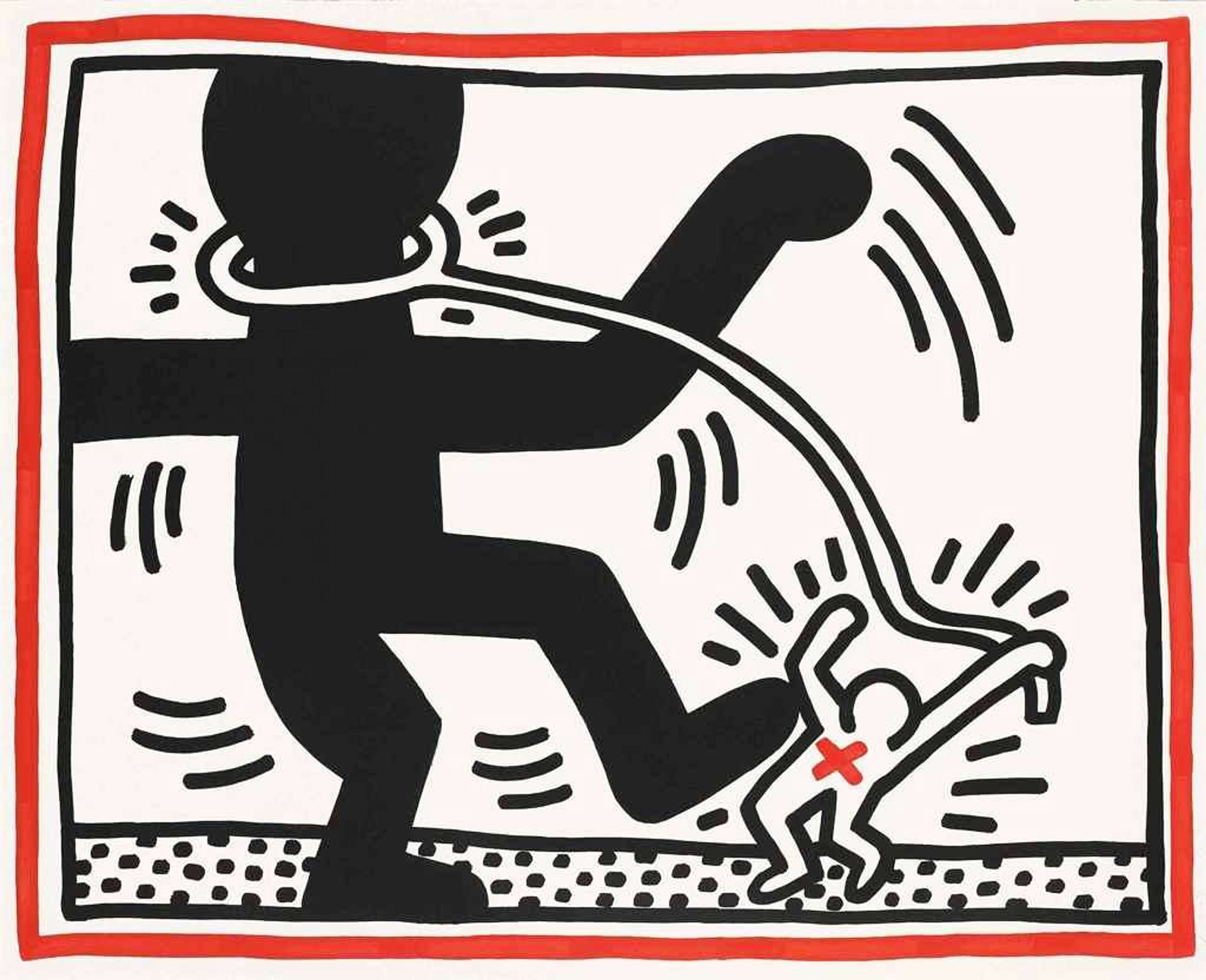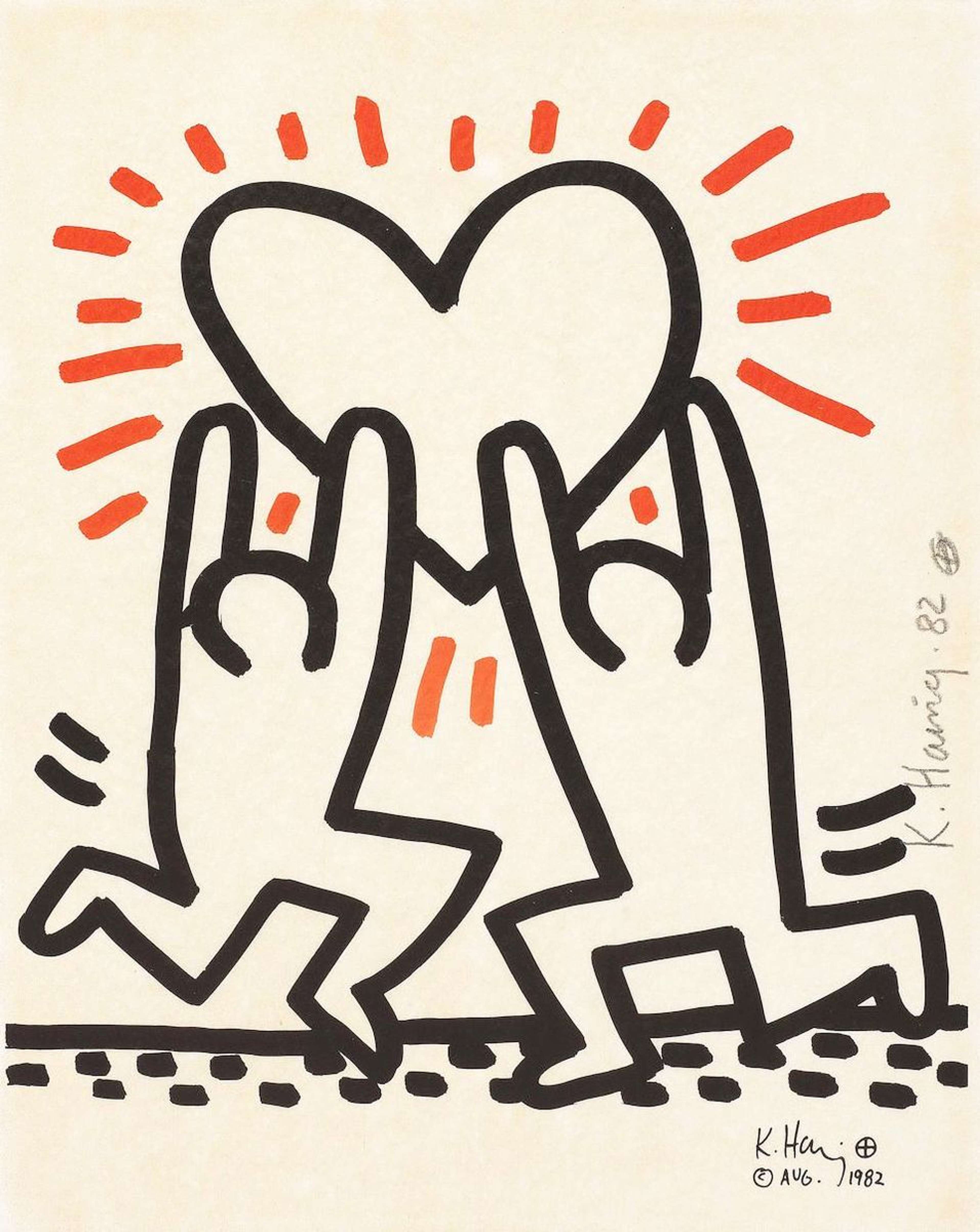10 Facts About Keith Haring's Free South Africa

 Free South Africa 2 © Keith Haring 1985
Free South Africa 2 © Keith Haring 1985
Interested in buying or selling
Keith Haring?

Keith Haring
249 works
Artist-cum-activist Keith Haring was a champion of freedom, justice, and unity. Throughout his artistic career, the Pop Artist used his work to raise awareness around some of the most pressing socio-political issues of his age. In his Free South Africa series, Haring turned his critical eye to the atrocities of apartheid in South Africa and visualised the overthrow of white supremacy.
The series represents emancipation from white supremacy in South Africa under apartheid.
 Free South Africa 2 © Keith Haring 1985
Free South Africa 2 © Keith Haring 1985Using his archetypal figures, Free South Africa represents a struggle between black and white characters. In each of the prints in this series, Haring depicts a small white figure with a noose, or leash, around the neck of a much larger black figure. The size of the figures symbolises the contrasting population sizes between black and white communities in South Africa, and underscores the irony of the white minority controlling and oppressing the black majority under apartheid.
The series was created during a period of pivotal civil rights activism in South Africa.
 The Star 12/02/90 © South Africa Gateway via Creative Commons
The Star 12/02/90 © South Africa Gateway via Creative CommonsThroughout the 1980s, the African National Congress (ANC) were embroiled in negotiations and campaigns to bring an end to apartheid. This was a decade underscored by both violent and peaceful protest, as the non-white population of South Africa showed the world the abhorrent realities of apartheid.
In the same year that Haring created this series, the apartheid government placed South Africa under yet another national State of Emergency, in a desperate attempt to maintain control. However, the ceaseless campaigning by non-white communities was not in vain. Just five years after Haring distributed his Free South Africa series, Nelson Mandela walked to freedom on 11 February 1990, setting the definitive end to apartheid in motion.
Haring allegedly distributed 20,000 poster versions of his Free South Africa 3 print to encourage support against apartheid.
 Free South Africa 3 © Keith Haring 1985
Free South Africa 3 © Keith Haring 1985In 1986, Haring had his Free South Africa 3 print formatted into a poster, making it easier to circulate the image to a wide-reaching demographic. These posters were then distributed around NYC to raise awareness about the atrocities of apartheid. This series exemplifies the power of Pop Art's ties to mass-circulated media, and the ways in which art can be used to illicit powerful socio-political change.
The portfolio uses Haring's archetypal figures to convey a troubling and pressing political concern.
 Pop Shop III, Plate II © Keith Haring 1989
Pop Shop III, Plate II © Keith Haring 1989Through his simple outlined figures, something Haring developed in his Subway Drawings, Haring portrayed narratives in a straightforward way to a universal audience. Much like his Pop Shop series, Free South Africa is defined by its child-like and naive characters, which reveal the sobering realities of racial injustice.
Haring was intrinsically against racial injustice.
 Fertility 3 © Keith Haring 1983
Fertility 3 © Keith Haring 1983Throughout his trailblazing artistic career, Haring utilised his art to spotlight minority groups facing injustice. In his Fertility Suite, for example, Haring drew attention to the overlooked devastation of the HIV/AIDS epidemic on pregnant women in Sub-Saharan Africa. Likewise, Free South Africa is a conspicuous critique of apartheid, and champions the black population who seemed on the precipice of stamping out white supremacy. As Haring himself wrote in a 1987 journal entry: "Control is evil. All stories of white men's 'expansion' and 'colonisation' and 'domination' are filled with horrific details of the abuse of power and the misuse of people."
Haring used simple mark-making to give his Free South Africa prints a sense of dramatic motion.
 Free South Africa 1 © Keith Haring 1985
Free South Africa 1 © Keith Haring 1985Emanating from the two focal figures in Free South Africa are dashes in black and red, suggesting the motion of the two struggling characters. This mark-making not only pronounces the gestures of Haring's simple figures, but conveys the physical and emotional pressures being applied to the Black population of South Africa under apartheid.
The series features Haring's motif of the cross to represent socio-political persecution.
 Three Lithographs 1 © Keith Haring 1985
Three Lithographs 1 © Keith Haring 1985The cross, or 'X', is a repeated symbol across Haring's oeuvre. In certain works, like his Three Lithographs, the cross appears at the centre of a circle, connoting individuality which should be preserved in the face of adversity. However, in Free South Africa, the red cross appears at the centre of his white figures. These symbols give the impression of a target on their bodies, making clear the force of evil that needed to be stamped out.
Haring also created public murals to promote socio-political change.
 Image CC BY-NC-SA 2.0 Núria / Berlin Wall Mural © Keith Haring 1986
Image CC BY-NC-SA 2.0 Núria / Berlin Wall Mural © Keith Haring 1986Free South Africa was certainly not Haring's only foray into socio-political activism. In fact, the Pop Artist produced public artworks on an immense scale to critique oppressive systems of power. Haring described his mural on the Berlin Wall, for example, as "an attempt to psychologically destroy the wall by painting it". Similar motivations drove his Free South Africa series, and inspired Haring to mingle his passions as both artist and activist.
Haring frequently used his eye-catching Pop Art in the service of social activism.
 Silence Equals Death © Keith Haring 1989
Silence Equals Death © Keith Haring 1989Throughout his life and artistic career, Haring committed himself to producing art which was democratic, and championed the voiceless or exploited in society. Perhaps his most prolific activist artworks are those he produced to raise awareness of the HIV/AIDS epidemic, which led to Haring's untimely death in 1990. However, Haring never limited himself to supporting one socio-political cause. Free South Africa is testament to Haring's relentless promotion of freedom, justice, and unity.
Free South Africa uses a visually simple iconography and colour palette to convey important messages without text.
 Bayer Suite 1 © Keith Haring 1982
Bayer Suite 1 © Keith Haring 1982Much like his Three Lithographs and Bayer Suite series, Free South Africa is composed of a simple red, black, and white colour palette. With his uncomplicated iconography and palette, Haring reduced his compositions to their most basic elements. In doing so, these politically loaded works became quickly and easily readable beyond all class, gender, sexual, and language barriers.